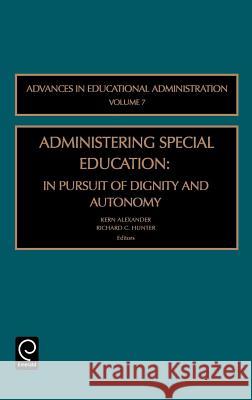Administering Special Education: In Pursuit of Dignity and Autonomy » książka
Administering Special Education: In Pursuit of Dignity and Autonomy
ISBN-13: 9780762311453 / Angielski / Twarda / 2004 / 264 str.
The administration of public schools encompasses myriad generic issues having to do with curriculum content, instructional methodology, human resource and financial management, and of course, the guidance and counseling of students. Woven into this tapestry is the obligation to individualize educational programs to accommodate the needs of a wide and diverse student population. The needs of children may be categorized by economic, social, ethnic, physical and mental differences unique to each child and family. It is incumbent upon the public school to accommodate these differences with specially designed educational programs and to remediate any effects that may be detrimental to learning. Prominent and unique among such programs is special education, for which the program of learning is usually separately funded at both federal and state levels, but even more importantly, the learning regimen is individually calibrated to address the needs of each child determined to have a disability. Indeed, assuring children with disabilities their statutory rights constitutes a substantial segment of public school administration in the United States today. The various ramifications of the educational needs of children with disabilities and their attendant circumstances are so extensive that one book on the subject cannot be sufficient to address the magnitude and broad scope of the field. However, in this book we have attempted to discuss several of the salient issues that are of prominent concern to both school administrators and teachers. The book proceeds from the broad consideration of rights and costs to more specific issues regarding the categorization of children and the disproportionality of the various racial and ethnic groups of children who may be improperly designated as disabled. Within the context of such classifications the book discusses the screening strategies on which the rights of children with disabilities are so delicately balanced. To inappropriately classify a child may result in a form of subtle discrimination or denial of a statutory right to the provision of a particular type of educational instruction or accommodation. As is indicated throughout this book, the assessment methods by which a child's free appropriate education is determined have become a science of considerable importance. Incident to this necessity of precise assessment is the need for risk screening strategies and protocols to identify symptoms, behaviors and indications of learning disabilities requiring particular and specialized educational redress. Among issues of greatest importance is the determination not to exclude children with disabilities from the regular classroom and the mainstream of learning. Inclusion or mainstreaming is among the most contentious and perplexing issues confronting school administrators. What constitutes the legal requirements and the educational considerations of the least-restrictive environment comes directly into play in provision of an appropriate education. Beyond the all-important inclusion issue, other chapters of this book address problems of cultural and social mores that affect children with disabilities, symptoms of depression in parents of children with disabilities, maltreatment of children with disabilities, and symptoms of children who have suffered post-traumatic stress from catastrophic events in their own lives. Each chapter suggests measures to be taken by educators in identifying and redressing such matters. Policy implications for the enhancement of the effectiveness of special education programs are identified for the school administrator to consider.











